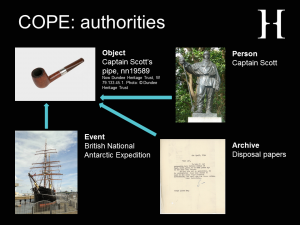I was flattered to receive an email a few months ago from Nick Poole, at that point still the Chief Executive of Collections Trust, asking me to speak at the Trust’s forthcoming annual conference. Nick suggested that I might ‘take a look at where we are today with documentation, which challenges have been solved and which are still to be addressed’ – all in twenty minutes! Those of you that know me will also realise that this isn’t really the way I work: I prefer to start with the detail and work outwards from that, rather than beginning with grand abstractions about the bigger picture. But after a quick exchange of emails, Nick and I agreed a subject, and I gave my lecture at the Collections Trust 2015 conference at the Natural History Museum a few weeks ago.
I’m not going to repeat the whole thing here, particularly as I managed to condense the whole thing into five tweets (just; I cheated a little), but I thought you might be interested in a summary, expanding just a little on my tweets. Here goes:
Museums are being asked to do more and more with fewer and fewer resources. If they work to improve their documentation, they will become both more efficient, and also more resilient.

More specifically, by reviewing and fine-tuning their documentation procedures, museums will be able to save themselves time and resources.
It’s important to realise that problems with museums’ current documentation are an inevitable result of their complex administrative histories, not of poor practice. We should therefore admit to them as a first step to persuading people to help us fix them.

Regarding data, we should follow the COPE principle: Create Once, Publish Everywhere. The best way to achieve this is to begin with our authority files, as a single entry there is often linked to more than one object record.1 Then we should use that work to improve the indexing of our object records, and – if we include narrative in our authority files – to quickly link contextual information to many object records.

So, if we follow the steps below, documentation will make museums resilient in the current difficult times, and help them flourish when the good times return:
- Documentalists:2
- Review and streamline your procedures
- Tidy and augment your data
- Senior managers and directors of museums:
- Resource and prioritise documentation
- Explain its importance to your governing bodies
- Governing bodies and Collections Trust:
- Argue, loudly, that documentation is crucial to museums’ resilience
- Funding bodies:
- Prioritise and fund projects which enable museums to manage their collections as efficiently as possible
It all seems very straightforward, doesn’t it?
But it depends very much on managers, directors, governing bodies, funders and organisations like Collections Trust and Arts Council England realising how important the role is that documentation can play in ensuring that museums are as efficient as possible, and I feel we still have some way to go here. In part, I think this is because of the continued problem of what I call ‘the invisibility of documentation’:3 what we do is just not visible to the people who set our objectives or pay for projects. I’m always interested in ways to address this problem, so I’d be delighted to hear of any examples you know of people or projects that have successfully raised the profile of documentation: feel free to add them to the comments section below.
For now, though, if this has whetted your appetite enough, you can read the full text of my lecture here.
Notes
- If you’re unfamiliar with the concept: authority files contain the preferred ways of entering names of people, organisations, places, publications,events, etc., in order to ensure that the same thing is always referred to in the same way. Significantly, in museum databases they often also contain additional information about the entities they represent. [↩]
- Really. [↩]
- Discussed at much greater length in a piece I wrote for the Registrar Trek blog. [↩]

